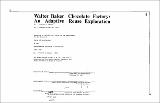Walter Baker Chocolate Factory : an adaptive reuse exploration
Author(s)
Castro, Fernando D
DownloadFull printable version (27.33Mb)
Alternative title
Exploration of adaptive reuse at Dorchester Lower Mills
Other Contributors
Massachusetts Institute of Technology. Department of Architecture.
Advisor
Barry Zevin.
Terms of use
Metadata
Show full item recordAbstract
This thesis explores the processes of building evolution and the methods in which old buildings are recycled for continued use. Reuse is the process in which a building's life is extended through a preservation or alteration of its existing morphology. It is a process in which memories are both extended and interpreted; designers try to renovate outdated structures into rich and diverse environments in which people can once again live and work. This thesis is a case study in reuse, in which I study the process of recycling several old industrial buildings. The Walter Baker Chocolate Factory sits on the boundary line between the Massachusetts towns of Milton and Dorchester, straddling the Neponset River. I discuss the morphology of the existing buildings, and I explore their conversion into an artists' colony. Reuse makes sense economically and environmentally, and also helps us preserve a connection to our ancestry, our cultural heritage, and our collective memory. In Working Places: the Adaptive Use of Industrial Buildings, Walter C. Kidney says: "America, at least in its attitude toward material wealth, may be undergoing a major psychological change. In the recent past, anything made the day before yesterday, whether it was a building, a car or a saucepan, was liable to be scrapped." Today, this trend is beginning to reverse, and architects are looking to explore the potential for reuse of outdated buildings. As a guide for my exploration, I have selected the program that the architectural team of Gelardin, Bruner, and Cutt used to create the "Piano Craft Guild", an artists' colony in the South End of Boston. I have, however, taken the freedom to tailor the program to fit the specific conditions extant at the east complex of the Walter Baker Chocolate Factory.
Description
Thesis (M. Arch.)--Massachusetts Institute of Technology, Dept. of Architecture, 1981. MICROFICHE COPY AVAILABLE IN ARCHIVES AND ROTCH. Includes bibliographical references (leaves 72-73).
Date issued
1981Department
Massachusetts Institute of Technology. Department of ArchitecturePublisher
Massachusetts Institute of Technology
Keywords
Architecture.